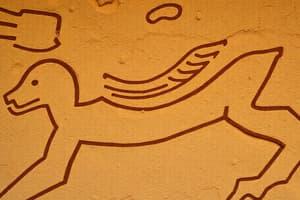Podcast
Questions and Answers
When did Homo sapiens emerge?
When did Homo sapiens emerge?
around 300,000 years ago
What kind of economy did Paleolithic societies practice?
What kind of economy did Paleolithic societies practice?
gathering and hunting
What is the term used to describe the era that represents over 95% of human history?
What is the term used to describe the era that represents over 95% of human history?
Paleolithic era
Which of the following describes the societal structure of Paleolithic societies?
Which of the following describes the societal structure of Paleolithic societies?
What major transformation occurred around 12,000 to 4,000 years ago?
What major transformation occurred around 12,000 to 4,000 years ago?
Which societies emerged most prominently in arctic tundra, grasslands, and deserts?
Which societies emerged most prominently in arctic tundra, grasslands, and deserts?
Life expectancy in Paleolithic societies was probably less than ______ years on average.
Life expectancy in Paleolithic societies was probably less than ______ years on average.
Which of the following was a result of the Agricultural Revolution?
Which of the following was a result of the Agricultural Revolution?
What was a common feature of societies dependent on domesticated animals?
What was a common feature of societies dependent on domesticated animals?
Flashcards
Paleolithic Era
Paleolithic Era
The period of human history marked by gathering and hunting.
Agricultural Revolution
Agricultural Revolution
The major transition to cultivating plants and domesticating animals.
Homo sapiens
Homo sapiens
The species of human beings we are.
Gathering and Hunting
Gathering and Hunting
Signup and view all the flashcards
Nomadic Societies
Nomadic Societies
Signup and view all the flashcards
Paleolithic societies
Paleolithic societies
Signup and view all the flashcards
Agricultural Societies
Agricultural Societies
Signup and view all the flashcards
Pastoral Societies
Pastoral Societies
Signup and view all the flashcards
Neolithic Age
Neolithic Age
Signup and view all the flashcards
Life Expectancy
Life Expectancy
Signup and view all the flashcards
Study Notes
Human History: From Paleolithic to Present
- Human Emergence: Homo sapiens emerged approximately 300,000 years ago, likely in Africa.
- Out of Africa: Between 100,000 and 60,000 years ago, humans began migrating across Eurasia, Australia, the Americas, and later, Pacific islands.
- Paleolithic Era: Early humans relied on foraging (gathering, scavenging, hunting, and fishing) and simple stone tools. Societies were small, nomadic bands, and highly egalitarian. Life expectancy was low, estimated around 35 years old.
Agricultural Revolution
- Neolithic/New Stone Age: Between 12,000 and 4,000 years ago, humans began cultivating plants and domesticating animals. This fundamentally transformed societies.
- Pastoral Societies: People in difficult environments (tundra, grasslands, deserts) relied more on domesticated animals for sustenance, creating nomadic pastoralist societies. These societies were mobile.
- Settled Farming Villages: Some groups settled in permanent villages, cultivating crops and raising animals. These societies retained high levels of social and gender equality.
- Chiefdoms: Some agricultural villages developed into chiefdoms, marked by an increase in social inequality with power based on lineage or personal charisma. Chiefs collected tribute.
- Rise of Civilizations: Agriculture provided the resources necessary for the development of civilizations, characterized by cities and states governed by kings.
Early Civilizations
- Characteristics of Civilizations: Large cities, states, and diverse occupations emerged. There was also an unprecedented amount of social inequality. Gender roles became more defined.
- Cultural Innovations: Civilizations fostered advancements in art, architecture, literature, and religion, as well as technological and scientific innovations. (e.g., Chinese civilization's bureaucracy and inventions; Islamic civilization's advances in math and medicine).
- Impact on the Environment: Growing populations and intensive agriculture changed the environments where civilizations thrived (deforestation, soil erosion, irrigation issues).
Cultural Traditions
- South Asia: Hinduism, one of the world's oldest religions, did not feature a single founder and encompasses a vast diversity of beliefs, practices, and deities. Buddhism, originating in the same region, challenged some Hindu norms emphasizing compassion and individual effort.
- East Asia: Confucianism emphasized moral behavior and social harmony with a focus on hierarchical relationships. Daoism emphasized harmony with nature through a belief in the natural order, often discouraging social or political engagement.
- Middle East: Judaism, Christianity, and Islam, known as Abrahamist faiths, all emphasized a singular God. Christianity transitioned from a small Jewish sect into a widely practiced religion in Europe.
- Importance of Trade Routes: Belief systems such as Buddhism, Christianity, and Islam spread along trade routes across Eurasia, impacting many different societies.
Mongols, Empires, and Trade
- Mongol Empire: This empire, in the 13th and 14th centuries, brought Eurasia into extensive contact, fostering trade and cultural exchange.
- Trade Routes: The Silk Roads, Sand Roads, and Sea Roads were vital for cultural diffusion and trade across the vast regions of Afro-Eurasia.
- Decline of the Mongol Empire: The Plague, internal conflicts, and evolving regional power structures all contributed to the decline of the empire.
The Plague
- Black Death: This devastating pandemic, spread by the Mongol trade networks, decimated populations in Afro-Eurasia, having significant social, economic, and political consequences.
European Empires
- European Advantages: In the Americas, European colonies were built largely on the basis of conquest from a distance, exploiting existing power structures and taking advantage of the lack of immunity to European diseases among the indigenous populations.
- Mercantilism: European motives for colonization and empire were deeply rooted in economic factors, using colonies to generate wealth for the "mother country."
- Colonial Societies in the Americas: These various colonies differed significantly depending on colonization methods. (e.g., plantation societies in the Caribbean, settler colonies in North America, and the Spanish conquest of the Aztec and Inca empires).
- The Columbian Exchange: The exchange of plants, animals, and diseases between Afro-Eurasia and the Americas significantly transformed both continents, shaping agriculture, local economies, and culture.
African Societies
- Transatlantic Slave Trade: This horrific system saw the forced migration of millions of Africans to the Americas, dramatically affecting both African and American societies.
- Impact on African societies: The slave trade disrupted social structures; led to economic stagnation in certain areas, but also provided opportunities for some African elites.
Studying That Suits You
Use AI to generate personalized quizzes and flashcards to suit your learning preferences.




